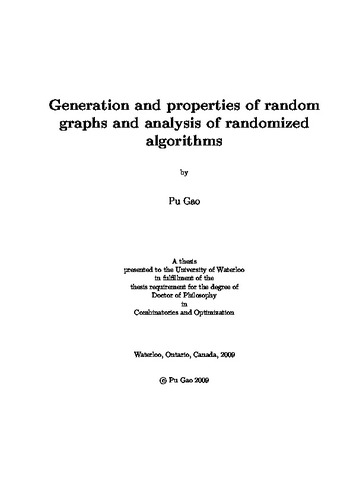| dc.description.abstract | We study a new method of generating random $d$-regular graphs by
repeatedly applying an operation called pegging. The pegging
algorithm, which applies the pegging operation in each step, is a
method of generating large random regular graphs beginning with
small ones. We prove that the limiting joint distribution of the
numbers of short cycles in the resulting graph is independent
Poisson. We use the coupling method to bound the total variation
distance between the joint distribution of short cycle counts and
its limit and thereby show that $O(\epsilon^{-1})$ is an upper bound
of the $\eps$-mixing time. The coupling involves two different,
though quite similar, Markov chains that are not time-homogeneous.
We also show that the $\epsilon$-mixing time is not
$o(\epsilon^{-1})$. This demonstrates that the upper bound
is essentially tight. We study also the
connectivity of random $d$-regular graphs generated by the pegging
algorithm. We show that these graphs are asymptotically almost
surely $d$-connected for any even constant $d\ge 4$.
The problem of orientation of random hypergraphs is motivated by the
classical load balancing problem. Let $h>w>0$ be two fixed integers.
Let $\orH$ be a hypergraph whose hyperedges are uniformly of size
$h$.
To {\em $w$-orient} a hyperedge, we assign exactly $w$ of its
vertices positive signs with respect to this hyperedge, and the rest
negative. A $(w,k)$-orientation of $\orH$ consists of a
$w$-orientation of all hyperedges of $\orH$, such that each vertex
receives at most $k$ positive signs from its incident hyperedges.
When $k$ is large enough, we determine the threshold of the
existence of a $(w,k)$-orientation of a random hypergraph. The
$(w,k)$-orientation of hypergraphs is strongly related to a general
version of the off-line load balancing problem.
The other topic we discuss is computing the probability of induced
subgraphs in a random regular graph. Let $0<s<n$ and $H$ be a graph
on $s$ vertices. For any $S\subset [n]$ with $|S|=s$, we compute the
probability that the subgraph of $\mathcal{G}_{n,d}$ induced by $S$
is $H$. The result holds for any $d=o(n^{1/3})$ and is further
extended to $\mathcal{G}_{n,{\bf d}}$, the probability space of
random graphs with given degree sequence $\bf d$. This result
provides a basic tool for studying properties, for instance the
existence or the counts, of certain types of induced subgraphs. | en |

